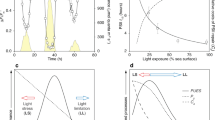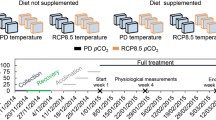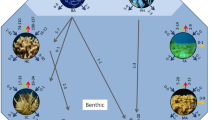Abstract
Sponge populations on Australia's Great Barrier Reef (GBR) may contain a mix of both phototrophic and heterotrophic species. The distribution of many of these sponges on reefs is assumed to be determined by light. A model was developed to investigate how the distribution of phototrophic sponges over depth is restricted by the availability of photosynthetically active radiation. Estimates of the balance between photosynthetic production and the total respiratory demand of entire sponge communities on Davies Reef (a middle-shelf reef of the Great Barrier Reef) are provided. These estimates are based upon published data for community composition and biomass, whilst photokinetic parameters have been determined for a variety of sponge species from oxygenexchange measurements. Phototrophic sponges on the fore-reef slope are predicted to exist at or above a state of net 24 h compensation (i.e., photosynthetic oxygen production by sponges balances or exceeds respiration over a 24 h period) to a depth of 30 m. It is proposed that phototrophic sponges are obligate phototrophs because the availability of light for photosynthesis corresponds with the lower depth limit of their distribution. Sponge communities (including both phototrophs and heterotrophs) from the fore-reef and lagoon exist close to a state of net 24 h compensation to a depth of 10 to 15 m. This balance shows diurnal variations, associated with the activity of phototrophs, such that instantaneous compensation of the community may occur to depths of 20 to 25 m when light is maximal.
Similar content being viewed by others
Literature cited
Begon, M., Harper, J. L., Townsend, C. R. (1986). Ecology. Individuals, populations and communities. Blackwell Scientific Publications, Oxford
Chalker, B. E. (1981). Simulating light-saturation curves for photosynthesis and calcification by reef-building corals. Mar. Biol. 63: 135–141
Chalker, B. E., Dunlap, W. C. (1983). Primary production and photoadaptation by corals on the Great Barrier Reef. In: Baker, J. T., Carter, R. M., Sammarco, P.W., Stark, K. P. (eds.) Proceedings of the Inaugural Great Barrier Reef Conference. James Cook University Press, Townsville, p. 293–298
Chalker, B. E., Dunlap, W. C., Oliver, J. K. (1983). Bathymetric adaptations of reef-building corals at Davies Reef, Great Barrier Reef, Australia. II. Light saturation curves for photosynthesis and respiration. J. exp. mar. Biol. Ecol. 73: 37–56
Jerlov, N. G. (1976). Marine optics. 2nd ed. Elsevier Scientific, Amsterdam
Jokiel, P. (1980). Solar ultraviolet radiation and coral reef epifauna. Science, N.Y. 207: 1069–1071
Larkum, A. W. D., Barret, J. (1983). Light harvesting processes in algae. Adv. bot. Res. 10: 1–219
Muscatine, L. (1986). Bioenergetics of reef-building corals. In: Thompson, M. F., Sarojini, R. Nagabhushanam, R. (eds.) Biology of benthic marine organisms: techniques and methods as applied to the Indian Ocean. Oxford, New Dehli, IBH Publishing Co., p. 297–306
Muscatine, L., McCloskey L. R., Marian, R. E. (1981). Estimating the daily contribution of carbon from zooxanthellae to coral animal respiration. Limnol. Oceanogr. 26: 601–611
Porter, J. W. (1976). Autotrophy, heterotrophy and resource partitioning in Caribbean reef-building corals. Am. Nat. 110: 731–742
Wilkinson, C.R. (1983). Net primary productivity in coral reef sponges. Science, N. Y. 219: 410–412
Wilkinson, C. R. (1987). Interocean differences in size and nutrition of coral reef sponge populations. Science, N.Y. 236: 1654–1657
Wilkinson, C. R., Cheshire, A.C. (1988). Growth rate of Jamaican coral reef sponges after Hurricane Allen. Biol. Bull. mar. biol. Lab., Woods Hole 175: 175–179
Wilkinson, C.R., Cheshire, A. C. (1989). Patterns in the distribution of sponge populations across the central Great Barrier Reef. Coral Reefs 8: 127–134
Wilkinson, C. R., Cheshire, A. C. (1990). Comparisons of sponge populations across the Barrier Reefs of Australia and Belize: evidence for higher productivity in the Caribbean. Mar. Ecol. Prog. Ser. 67: 285–294
Wilkinson, C. R., Cheshire, A. C., Klumpp, D. W., McKinnon, A. D. (1989). Nutritional spectrum of animals with photosynthetic symbionts — corals and sponges. Proc. 6th. int. coral Reef Symp. 3: 27–30 [Choat J. H. et al. (eds.) Sixth International, Coral Reef Symposium Executive Committee, Townsville]
Wilkinson, C. R., Evans, E. A. (1989). Sponge distribution across Davies Reef, Great Barrier Reef relative to location, depth, and water movement. Coral Reefs 8: 1–7
Wilkinson, C. R., Trott, L. A. (1985). Light as a factor determining the distribution of sponges across the central Great Barrier Reef. Proc. 5th. int. coral Reef Congr. 5: 125–130 [Gabrié, C. et al. (eds.) Antenne Museum — EPHE, Moorea, French Polynesia]
Author information
Authors and Affiliations
Additional information
Communicated by G.F. Humphrey, Sydney
Rights and permissions
About this article
Cite this article
Cheshire, A.C., Wilkinson, C.R. Modelling the photosynthetic production by sponges on Davies Reef, Great Barrier Reef. Mar. Biol. 109, 13–18 (1991). https://doi.org/10.1007/BF01320226
Accepted:
Issue Date:
DOI: https://doi.org/10.1007/BF01320226




